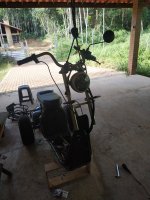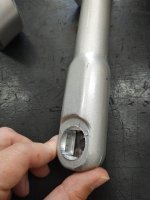Adding a Second Hub Motor to My Electric Citycoco Trike: A DIY Modification Guide with VESC Controllers, Light Control, High-Current Connectors, Improved Climbing Performance, and Milling Tips
Introduction: Electric trikes, like the Citycoco, offer an excellent combination of stability, ease of use, and eco-friendly transportation. However, there's always room for improvement! In this text, I'll share my experience in modifying my Citycoco trike by adding a second hub motor on the front fork, ultimately enhancing its performance and efficiency. In this modification, I used two VESC controllers (Flipsky 75100 and 75200) connected via CAN bus for synchronized motor control, installed an "Ewheel ADC Adapter V2" from Spintend for light control, and utilized XT150 connectors and an anti-spark switch for high-current handling and safety. I also chose a QSmotor 2000W hub motor for its superior quality, and I'll discuss the significant improvement in climbing steep slopes after the modification. Additionally, I'll provide some milling tips for a smooth and accurate modification process.
Step 1: Gathering Necessary Tools and Materials Before starting the modification, gather the following tools and materials:
- Electric Citycoco trike
- QSmotor 2000W hub motor
- Flipsky 75100 and 75200 VESC controllers
- Ewheel ADC Adapter V2
- XT150 connectors
- Anti-spark switch rated for 16S or higher
- 12V horn
- Wide Velcro tape
- Basic tools for disassembly and reassembly (wrenches, screwdrivers, etc.)
Step 2: Removing the Front Wheel Begin by removing the front wheel from your Citycoco trike.

Step 3: Preparing the Front Fork for the Second Hub Motor Before installing the second hub motor, I had to remove the dampers from the front fork where the front wheel is connected. When taking the fork to a local shop to have a square milled into them, it's essential to start milling the side where the brake pinch is, as it should be in a fixed position relative to the brake disc. This ensures proper alignment for the braking system.
Once the first side is milled correctly, measuring and milling the other side becomes easier. Simply mill a hole to fit the rest of the axle. To make this process more accurate, I recommend bringing the steering table to the shop, allowing the technicians to precisely measure the distances between the dampers and the holes.

Step 4: Installing the Second Hub Motor For this modification, I highly recommend using a QSmotor 2000W hub motor. This motor offers superior quality compared to the original motor on my trike, featuring thicker cables for better current handling.
Step 5: Wiring the Second Hub Motor and VESC Controllers Since the current in the system is very high, I used XT150 connectors to connect the wires from the hub motors to the VESC controllers. These connectors are designed to handle high currents and provide a secure, reliable connection.
Step 6: Configuring the VESC Controllers, Installing the Ewheel ADC Adapter V2, and Anti-Spark Switch To ensure optimal performance and control of both hub motors, I used two VESC controllers, Flipsky 75100 and 75200. I connected them via CAN bus, allowing the controllers to communicate with each other and synchronize the rotation of the motors. After connecting the controllers to the motors and the trike's existing electrical system, I followed the manufacturer's instructions to configure the settings on both controllers.
Step 7: Securing Components with Velcro Tape and Reinstalling the Front Wheel To keep all the components secure and organized inside the trike, I used wide Velcro tape. This versatile and easy-to-use solution holds everything in place, preventing any movement or damage during rides. After securing the components, I reinstalled the front wheel and proceeded to the testing phase.
Step 8: Testing the Modified Trike With the second hub motor installed and all components in place, I took my modified Citycoco trike for a test ride. To my delight, I found that the trike could now easily climb very steep slopes, even with my weight of 95 kg. This was not possible with just one motor, showcasing the significant improvement in performance after the modification.
Conclusion: The addition of a second QSmotor 2000W hub motor, the use of Flipsky VESC controllers, the installation of an "Ewheel ADC Adapter V2" from Spintend, and the implementation of XT150 connectors and an anti-spark switch for high-current handling and safety have significantly improved my Citycoco trike's performance. This DIY modification provides better traction, increased power, seamless light control, enhanced safety features, and the ability to climb steep slopes even for heavier riders. By following the milling tips provided, you can ensure a smooth and accurate modification process. If you're looking to enhance your Citycoco trike's performance, consider adding a second hub motor, using VESC controllers, and incorporating these components by following these steps. Happy riding!


![en-3wheel5_1000x[1].jpg en-3wheel5_1000x[1].jpg](https://endless-sphere.com/sphere/data/attachments/189/189518-e8f791a71902e8430baecac2dd92fb13.jpg)

